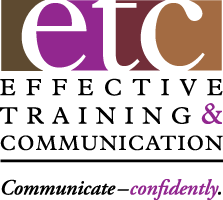Looks like you enjoyed our discussion of Gesturing Worst Practices last month. Except, of course, for those of you who thought I was describing what you do – sorry about that! So, how do you gesture more effectively? Fasten your seat belts for a quick spin around Gesturing BEST Practices.
You’ll recall that what you do – and don’t do – with your hands says a lot about your confidence and credibility on the platform:
* Since you can’t eliminate all the nervous energy Presentation Anxiety produces, channel it productively with strong and purposeful gestures. Work off those extra calories.
* Because the eyes of your audience are drawn to movement, make sure your hands send them the clear non-verbal message that you’re confident and … cool.
* The best gestures add visual value and punch to your message and appear to be on purpose and for a purpose.
New or Different Tools
That all said, here are 10 simple but not easy techniques to Harness Physical Energy through your Gestures:
- Keep your hands in a ‘Neutral’ position most of the time – arms at your side, relaxed, with your hands open and fingers pointing downward. Unless you’re holding notes in one hand, this ‘Neutral’ position is where your hands belong when you’re not gesturing.
- Let your fingers be as motionless as possible without looking stiff or unnatural. When you feel the need to fidget, that’s time for a more productive gesture instead.
- When you do gesture, bring your hands up well above your waist. The closer your hands are to your face, the better. This will keep audience attention on the parts of your body you do want them to look at.
- Use a non-predictable combination of one-hand and two-hand gestures for variety and emphasis. Avoid overdoing the same movement. Productive gestures are like the spice in pasta sauce. They make it memorable, but a little goes a long way.
- If you are holding notes, make sure they’re in your non-gesturing hand and that you don’t also gesture with the notes or hold them with both hands.
- If you want to put your hands together, do so for a reason and don’t keep them together very long.
- When you want to use a gesture to transition from point #1 to point #2, simply move your hand up or across to accent what you say. You don’t need to hold up two fingers.
- It’s fine to put a hand in your pocket occasionally to project a more relaxed and casual non-verbal image. But, keep it still and remember that a little goes a long way. Really limit this if you need to hold notes to avoid the temptation to gesture with your note hand.
- If you must stand behind a podium – and there are some good reasons to do so – make sure your gestures are shoulder height or higher so the audience can see them.
- Don’t hold on to the sides of the podium. When not gesturing, place your hand on the angled top surface. Leave your notes on the podium to avoid holding them.
So there you are – BEST Practices to help you gesture on purpose and for a purpose and project the appearance of confidence, credibility and competence to your audience. When you give your audience a ‘hand’ in the right way, they may respond by giving you a hand, too. Applause, that is.
